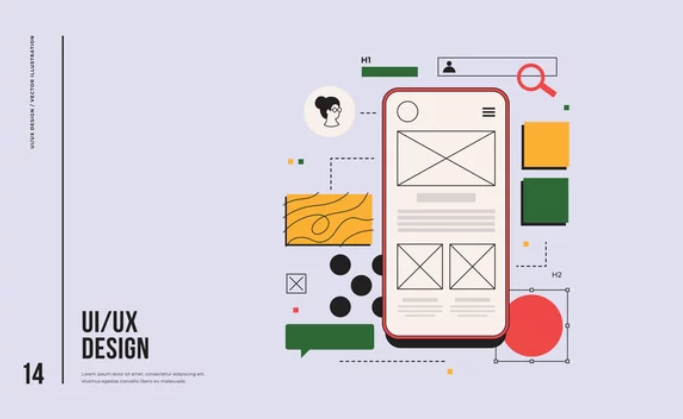Table of Contents
ToggleIntroduction.
In today’s hyper-connected world, digital experiences shape how we communicate, learn, shop, and live. From mobile apps and websites to smart devices and virtual platforms, design touches nearly every aspect of daily life. But amid the pursuit of beauty, innovation, and seamless interaction, one crucial principle sometimes gets overlooked accessibility. Accessibility in UX design is about creating experiences that work for everyone, regardless of ability, situation, or context.
It’s about ensuring that no one is left out of the digital conversation simply because a design wasn’t built with them in mind. A visually impaired user should be able to navigate a website with a screen reader just as smoothly as a sighted user scrolls through it. Someone with limited mobility should find it effortless to interact with buttons, forms, and menus. A person with hearing loss should never miss out on a video’s message because it lacks captions. Accessibility is not a technical afterthought or a checklist item to satisfy regulations it is a core aspect of human-centered design that embodies empathy, inclusivity, and respect.
When we talk about UX, we often emphasize usability, aesthetics, and engagement. But true usability means being usable for all people, not just those who fit a certain demographic or have typical sensory and motor abilities. Accessibility challenges designers to think more broadly, to imagine users navigating interfaces in ways they themselves might never experience. It’s a shift from designing for the “average user” to designing for the real world, where users are diverse, complex, and beautifully varied. It means asking questions like: Can this button be accessed by someone using only a keyboard? Is this color contrast strong enough for someone with low vision? Does this animation affect users with motion sensitivity? These small considerations add up to enormous improvements in user experience.
The importance of accessibility goes beyond ethics it’s also practical and powerful. Studies show that accessible design improves SEO, increases audience reach, and enhances overall usability for everyone. Think about closed captions on videos originally designed for the hearing impaired, yet now widely used by viewers in noisy environments, public spaces, or quiet offices. Accessibility features often end up benefiting all users, because they align with the principles of clarity, simplicity, and flexibility that define excellent UX. In essence, accessibility isn’t just about helping people with disabilities; it’s about designing experiences that adapt gracefully to a wide range of human needs and environments.
Moreover, accessibility is a legal and moral responsibility. In many countries, accessibility is mandated by laws such as the Americans with Disabilities Act (ADA) or guided by standards like the Web Content Accessibility Guidelines (WCAG). But following these rules shouldn’t be seen as an obligation it’s an opportunity to create better, more inclusive products. A design that accommodates different abilities also demonstrates empathy, foresight, and professionalism. It reflects a brand’s values and sends a message: “You are welcome here.”
Designers who embrace accessibility are, in truth, expanding their creative potential. Far from limiting innovation, accessibility inspires it. It challenges us to simplify interfaces, clarify communication, and remove unnecessary friction. It encourages collaboration across disciplines designers, developers, researchers, and users to create systems that truly serve people. The most impactful digital experiences are those that feel effortless and intuitive to everyone, regardless of who they are or how they interact with technology.
As technology continues to evolve, the boundaries of accessibility are expanding, too. Voice interfaces, AI-driven personalization, and assistive technologies are reshaping how users engage with digital products. The future of UX design will depend not just on how fast we innovate, but on how inclusively we design. Accessibility isn’t a destination or a one-time project; it’s a continuous process of learning, testing, and improving. Each iteration, each design decision, each line of code brings us closer to digital equality.
At its core, accessibility in UX is about empathy in action understanding that design has real-world consequences. It can empower or exclude, enlighten or confuse, include or alienate. As creators of digital experiences, we hold the power to shape not only interfaces but also lives. When we design with accessibility in mind, we make technology more human, more equitable, and more meaningful. And that, ultimately, is the essence of great user experience.
What Is Accessibility in UX Design?
Accessibility in UX design is the practice of creating digital experiences that can be easily used, understood, and enjoyed by people of all abilities. It’s about designing interfaces that don’t just look good but work well for everyone, regardless of physical, cognitive, sensory, or situational limitations. In essence, accessibility ensures that every user, no matter their circumstance, can perceive, navigate, and interact with a product without unnecessary barriers. It’s a fundamental component of user-centered design, built on empathy and inclusion. When we design for accessibility, we’re not designing for “special cases” we’re designing for the full spectrum of human diversity.
In practical terms, accessibility means anticipating how different people might engage with technology. A user with a visual impairment may rely on a screen reader to interpret text and images; someone with limited motor control may navigate using a keyboard instead of a mouse; a person who is deaf or hard of hearing might depend on subtitles or transcripts to access audio content; and users with cognitive differences may require simple, consistent layouts and clear language to reduce cognitive load. These are not exceptions they’re everyday realities for millions of users worldwide. The goal of accessibility is to make sure that such users are not excluded from digital participation simply because of poor design choices.
Accessibility also extends beyond permanent disabilities. It encompasses situational and temporary limitations that affect how people interact with interfaces. For example, a parent holding a baby in one arm has limited ability to use both hands; someone using a smartphone in bright sunlight may struggle with color contrast; or a user with a slow internet connection may need lightweight, optimized designs. These real-life contexts show that accessibility is not just for people with disabilities it’s for everyone, everywhere, at all times. It’s about designing experiences that flex and adapt to human needs, rather than forcing users to adapt to rigid systems.
From a design perspective, accessibility touches every layer of the UX process from research and wireframing to interaction design and content strategy. It means thinking about color contrast while choosing a palette, ensuring sufficient text size and spacing during layout design, adding alt text for images, and structuring content with semantic HTML for assistive technologies. It also involves writing clear and descriptive copy, designing predictable navigation, and offering multiple ways to complete a task. Accessibility is not a single feature or plugin; it’s a holistic approach that influences every decision you make as a designer.
Technically, accessibility in UX is guided by standards like the Web Content Accessibility Guidelines (WCAG), which define how to make digital content perceivable, operable, understandable, and robust principles often summarized as P.O.U.R.. These guidelines are not just for compliance; they serve as practical frameworks to help designers create products that are usable and enjoyable by all. When applied thoughtfully, they result in interfaces that feel intuitive, flexible, and humane.
But beyond compliance and technical checklists, accessibility is ultimately about empathy. It’s about recognizing that every click, tap, and scroll represents a person with unique needs, emotions, and expectations. Designers who practice accessibility approach their craft with a sense of responsibility understanding that design has the power to include or exclude. When accessibility is baked into the design process from the start, it ceases to feel like a burden and instead becomes a natural expression of good design ethics.
Accessibility in UX is also deeply connected to innovation. Some of the most groundbreaking technologies like voice assistants, speech-to-text tools, and high-contrast modes were originally designed for accessibility but later became mainstream because they improved convenience for everyone. This proves a powerful truth: designing for inclusion doesn’t narrow creativity; it broadens it. By focusing on accessibility, designers uncover new opportunities to improve clarity, simplicity, and usability.
In the end, accessibility in UX design is about ensuring that technology serves people all people. It transforms design from being exclusive and aesthetic-driven to being inclusive and purpose-driven. It bridges gaps, builds trust, and creates meaningful connections between users and digital products. A truly accessible design doesn’t call attention to itself; it simply works, seamlessly and effortlessly, for anyone who encounters it. That’s the beauty of accessibility when done right, it’s invisible, yet deeply empowering. It turns interfaces into invitations, allowing every user, regardless of ability or context, to participate fully in the digital world.
Why Accessibility Matters
1. It’s About Human-Centered Design.
At its core, accessibility matters because it embodies the principles of human-centered design, which prioritizes the needs, abilities, and experiences of real people over aesthetic trends or technological novelty. Human-centered design is about empathy understanding users as individuals with diverse backgrounds, abilities, and contexts and accessibility is its natural extension. When designers create accessible experiences, they acknowledge that every user navigates the digital world differently, and that design should adapt to meet them where they are. This means considering visual, auditory, motor, and cognitive differences, as well as situational limitations like using a device in bright sunlight or with one hand occupied. It’s about designing for people, not for a hypothetical “average user.”
Accessibility in UX is fundamentally inclusive. By ensuring that interfaces are usable by as many people as possible, designers are practicing empathy in action. Features like keyboard navigation, screen reader compatibility, clear labeling, and sufficient color contrast aren’t just technical requirements they are ways to honor the needs of every individual interacting with a product. When accessibility is prioritized, design becomes more thoughtful, deliberate, and intentional, forcing designers to scrutinize assumptions about how users perceive, interact with, and respond to content. It transforms the design process from being self-referential to being outward-focused, centering on human experience rather than personal preference.
Moreover, accessibility enhances usability for everyone. Consider closed captions, originally designed for the hearing impaired, now widely used in noisy environments or public spaces. Or think of high-contrast text and clear visual hierarchy, which improve readability for all users, not just those with low vision. By designing inclusively, UX professionals create experiences that are not only ethical but also smarter, more adaptable, and more efficient. Human-centered design and accessibility are intertwined: both prioritize understanding the user, removing barriers, and creating products that empower rather than frustrate.
Ultimately, accessibility is a moral and practical commitment to human dignity in digital spaces. It ensures that no one is excluded, ignored, or marginalized due to design choices. By centering design around real human needs and abilities, designers uphold the essence of what UX is meant to be: a bridge between technology and humanity. Accessible, human-centered design isn’t just a best practice it’s a responsibility, a mindset, and a standard for creating products that genuinely serve all users.
2. It’s Good for Business.
Accessibility isn’t just a moral or ethical consideration it’s also a smart business strategy. Designing inclusive digital experiences expands your potential audience, reaching millions of users who might otherwise be excluded due to disabilities or situational limitations. According to the World Health Organization, over 1 billion people worldwide live with some form of disability, representing a significant market that businesses cannot afford to overlook. By implementing accessible design, companies tap into this underserved audience, creating products that are usable, enjoyable, and engaging for more people. Accessibility, therefore, directly translates into increased customer reach and brand loyalty.
Moreover, accessible design improves customer satisfaction and retention. Users who can easily navigate, understand, and interact with a product are more likely to engage, convert, and return. Frustrating or inaccessible experiences drive users away, while inclusive design fosters trust and loyalty. Accessibility also signals that a brand values diversity and inclusion, which resonates strongly in today’s socially conscious market. Consumers increasingly expect brands to demonstrate empathy and responsibility, and accessible design is a tangible way to deliver on that expectation.
From a financial perspective, incorporating accessibility early in the design process is far more cost-effective than retrofitting solutions later. Accessibility is easier to integrate during wireframing, prototyping, and development than to correct after a product has launched. Neglecting accessibility can lead to reputational damage, legal liabilities, and lost revenue. Many countries enforce digital accessibility standards through regulations such as the Americans with Disabilities Act (ADA) in the U.S. or the European Accessibility Act in the EU, and non-compliance can result in costly lawsuits. Designing inclusively from the outset protects businesses from legal and financial risks.
Additionally, accessible design enhances search engine optimization (SEO) and overall usability, which benefits business performance. Features like descriptive alt text for images, structured headings, and readable content improve how search engines interpret and rank web pages, leading to increased visibility and organic traffic. Accessibility improvements often align with broader UX best practices, creating more intuitive and efficient interfaces for all users. In this sense, accessibility is not a limitation it’s an opportunity to optimize products and maximize impact.
In short, accessibility is a win-win: it serves users and strengthens business outcomes. It opens doors to new markets, deepens customer loyalty, ensures legal compliance, and improves usability and discoverability. By embracing accessibility, businesses demonstrate foresight, empathy, and a commitment to inclusion, all of which are key drivers of sustainable growth in today’s competitive digital landscape. Designing for everyone isn’t just the right thing to do it’s the smart thing to do.
3. It Improves Overall Usability.
Accessibility and usability go hand in hand. When you design with accessibility in mind, you are essentially improving the experience for all users, not just those with disabilities. Usability is about making interfaces intuitive, efficient, and satisfying to interact with, and accessible design ensures that these principles extend across diverse needs and contexts. For example, clear navigation, high-contrast text, and descriptive labels help users with visual impairments, but they also make the interface easier to understand for first-time visitors, older users, or anyone using a device in challenging environments. Accessibility essentially removes friction from the user journey.
Consider keyboard navigation and focus indicators. While these features are essential for users with motor impairments who may not be able to use a mouse, they also improve usability for power users who rely on shortcuts and keyboard commands. Similarly, captions on videos serve users who are deaf or hard of hearing but also help viewers in noisy settings, commuters using mobile devices in public, or anyone who prefers reading along while listening. By thinking inclusively, designers create interfaces that anticipate user needs and reduce barriers, leading to smoother, more enjoyable interactions.
Accessible forms, clear error messaging, and readable typography not only meet accessibility standards but also enhance efficiency and comprehension for every user. People spend less time guessing how to complete tasks or fix mistakes, which reduces frustration and increases satisfaction. Simplifying content, organizing information logically, and providing multiple ways to interact with a system all contribute to better usability. Accessibility encourages designers to focus on clarity, consistency, and predictability, which are hallmarks of excellent UX design.
Moreover, accessible interfaces are inherently flexible and resilient. They work across different devices, screen sizes, and contexts, improving the overall experience for mobile users, low-bandwidth environments, or older hardware. Accessibility prompts designers to anticipate diverse use cases, creating products that are more robust and adaptable. In this way, the principles of accessibility reinforce universal design design that is inherently usable, intuitive, and effective for everyone.
Accessibility elevates the quality of the entire user experience. By prioritizing inclusive design, teams create interfaces that are easier to navigate, understand, and interact with, no matter who the user is or how they engage with technology. Improving accessibility is, therefore, synonymous with improving usability. It benefits users with disabilities, situational limitations, or temporary challenges, while also enhancing efficiency, satisfaction, and engagement for all users. In essence, accessible design is good design it creates a seamless experience that works for everyone, strengthens user trust, and demonstrates a commitment to thoughtful, human-centered UX.
Core Principles of Accessible UX Design
The Web Content Accessibility Guidelines (WCAG) outline four main principles — summarized as P.O.U.R.:
1. Perceivable
Users must be able to see or hear your content.
- Provide alt text for images.
- Ensure color contrast between text and background.
- Offer captions or transcripts for videos and audio.
2. Operable
Users must be able to interact with your interface.
- Make sure all features are keyboard accessible.
- Avoid animations that can trigger motion sensitivity.
- Provide enough time to complete tasks.
3. Understandable
Users must be able to comprehend your content.
- Use clear, plain language.
- Keep navigation consistent.
- Offer helpful error messages and form validation.
4. Robust
Your design should work across a variety of devices and assistive technologies.
- Use semantic HTML.
- Test with screen readers and accessibility checkers.
Practical Tips for Designers
- Don’t rely on color alone to convey information (use icons, labels, or patterns too).
- Use scalable typography for users who zoom in.
- Add focus states for buttons and links so keyboard users know where they are.
- Design with real people include users with disabilities in your testing.
- Check contrast using tools like Contrast Checker or Stark.
Accessibility is not a checklist it’s a mindset.
Common Accessibility Myths
Myth 1: “Accessibility makes design boring.”
→ Reality: Constraints often spark creativity. You can be accessible and visually stunning.
Myth 2: “It’s too expensive to implement.”
→ Reality: It’s cheaper to build accessibility in from the start than to retrofit it later.
Myth 3: “Only a small group of people need it.”
→ Reality: Over 1 billion people worldwide live with a disability. Accessibility is for everyone.
Tools & Resources
- WCAG 2.2 Guidelines – Official accessibility standards.
- WAVE – Accessibility evaluation tool.
- Stark Plugin (Figma/Sketch/XD) – Checks color contrast and simulates visual impairments.
- axe DevTools – Browser extension for testing accessibility.
Final Thoughts
Accessibility in UX isn’t just about compliance it’s about compassion. It’s about making sure no one feels excluded from the digital world.
When you design for accessibility, you design for real life for the person reading in bright sunlight, for the parent holding a baby in one arm, for the user who relies on a screen reader.





